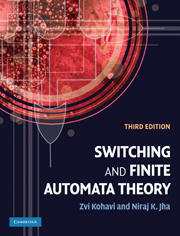Book contents
- Frontmatter
- Contents
- Preface
- Part 1 Preliminaries
- Part 2 Combinational logic
- 3 Switching algebra and its applications
- 4 Minimization of switching functions
- 5 Logic design
- 6 Multi-level logic synthesis
- 7 Threshold logic for nanotechnologies
- 8 Testing of combinational circuits
- Part 3 Finite-state machines
- Index
5 - Logic design
from Part 2 - Combinational logic
Published online by Cambridge University Press: 05 June 2012
- Frontmatter
- Contents
- Preface
- Part 1 Preliminaries
- Part 2 Combinational logic
- 3 Switching algebra and its applications
- 4 Minimization of switching functions
- 5 Logic design
- 6 Multi-level logic synthesis
- 7 Threshold logic for nanotechnologies
- 8 Testing of combinational circuits
- Part 3 Finite-state machines
- Index
Summary
The principal application of switching theory is in the design of digital circuits. The design of such circuits is commonly referred to as logical (or logic) design. Most digital systems are constructed from electronic switching circuits. In this chapter, we describe some components that are typical of the basic building blocks used in constructing digital systems. Switching algebra will be used to describe the logical behavior of networks composed of these building blocks as well as to manipulate and simplify switching expressions, thereby reducing the number of components used in the design. We shall be concerned with the logic functions that a circuit performs rather than with its electronic structure or behavior. Special attention will be given to the design of high-speed binary adders. These examples will introduce us to some practical aspects of logic design in which the speed of operation and area limitations require ingenuity in arriving at a proper compromise.
Design with basic logic gates
Although modern digital systems are composed of a large number of components, they usually employ only a small number of different kinds of elementary circuits, called gates, whose task is to perform logic operations on input signals. In Section 3.2, we showed that in order to implement any switching function, it is necessary to have a set of two-valued switching devices capable of implementing a functionally complete set of operations. The objective of this section is to present some commonly used devices of this type.
- Type
- Chapter
- Information
- Switching and Finite Automata Theory , pp. 108 - 150Publisher: Cambridge University PressPrint publication year: 2009



